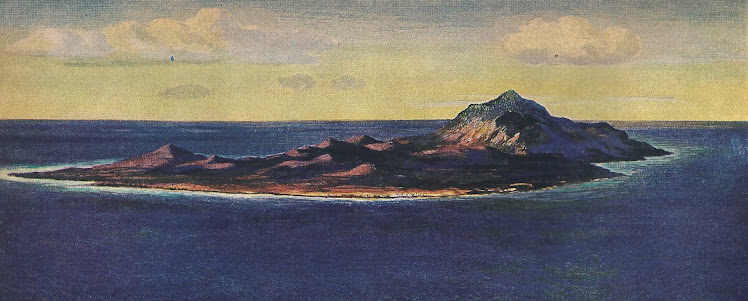Thanks to my grandmother Mrs. Roy Chapman--articles like this one were saved in a scrapbook.
From the Reader's Digest
January 1944
by John Gunther
"'Why if a crow tried to land here, he'd break a leg.' That was an early military report on Ascension.
One of the most remarkable bits of evidence I have ever seen of American enterprise, guts, imagination and tenacity is the airport we have gouged out of volcanic rock on this unknown island, a naked dot of lava in the middle wastes of the South Atlantic. Everyday from here, flights take place that help us win the war. It is an essential pivot in the great route from New York and Miami to Africa, the Middle East, Russia, India and China."
Building a hangar on Ascension. One of the photos I found in my father's footlocker after his death.
Now I can for the first time lift part of the veil that has shrouded Ascension.
I had the great good luck to land on Ascension on my way from Europe and Africa in September. It's an experience not easily forgotten. Ascension measures five miles by seven. It lies roughly halfway between the downward bulge of Africa and the outward bulge of Brazil. To be precise, it is 1362 statute miles from Accra, on the African Gold Coast, and 1448 miles from Natal. Nonstop flights across the South Atlantic between Africa and Brazil are perfectly practicable, and have been done thousands of times. But the alternative triangular course gives our ferry and bomber pilots a comfortable margin of extra gasoline, pay load--and safety.
Ascension fills almost the role in the South Atlantic that the Azores furnish in the Central Atlantic. It is a stopping-off place, a marvelously convenient midway station, in the perilously long transatlantic run. It is God's gift to ocean fliers, a place where they can come down. Also use of Ascension means that smaller planes with less range--like fighters of some categories--can now cross the Atlantic under their own power.
Ascension is the loneliest and most isolated place I have ever seen on earth, or water. Before the war, not more than one ship a year touched there. The nearest land is St. Helena, about 800 miles away, where Napoleon was 'detained' by the British until his death in 1821. Except for that, there is nothing but the vastness, the inconceivable emptiness of the Atlantic. The British first picked Ascension for Napoleon's exile, but then reconsidered. Ascension was, they thought, too lonely.
Discovered by a Portuguese sea captain on Ascension Day in 1501, the island remained uninhabited for more than 300 years. Later, the British built a cable station there. Today, there are about 75 British subjects on this water-swept, sun-scoured chunk of rock, including six or eight women. There are no native islanders; it is one of the few places in the world that never had aborigines.
Look at Ascension now. The whole island is swarming with crowded activity. Several thousand American troops comprise its lively, vigorous garrison. Everywhere you hear the accent of Iowa or the Carolinas. We have built hangars, machine shops, barracks, hospitals, rifle ranges, mess halls, storage dumps, an overnight hostel for air passengers, and all the multifarious paraphernalia a great new airport needs. There are four open-air theaters on Ascension now and four baseball fields."
Competitive baseball games on Ascension kept the troops entertained when they weren't working. There wasn't much else to do!
"But the pride of the island is, of course, its runway. British engineers said frankly that it could not be built. It was built. It was built in 91 days. This was a record in itself. I have never seen a runway like it. It stretches 7000 feet, scalloped out of the side of a rust-colored mountain. Right in the middle, there is a sloping hump. Our engineers made the runway, and it works; but they couldn't smooth down that hump. No dynamite, no TNT, was powerful enough to blast through the final shelves of that red volcanic rock.
We stepped out of our C-54--the four motored Douglas that the ATC likes to use for transatlantic hops--at about 11:45 a.m. It has taken us just six hours and 20 minutes to fly the 1362 miles from Accra. It was one of the finest flights I ever had, as smooth as soap, with Captain G.C. Gibbs. He decided that something was mildly wrong with one motor. So instead of half an hour at Ascension, we had until the middle of the afternoon. Mechanics swarmed like monkeys over the inner starboard motor, and we had time to see the island."
(Continued tomorrow ....)




No comments:
Post a Comment